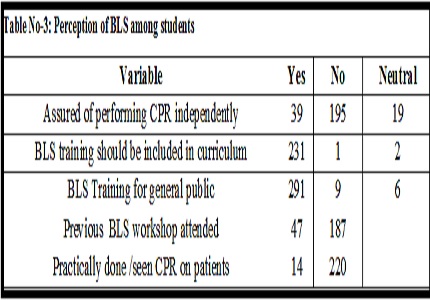Level of knowledge and perceptions of basic life support among under graduate medical students in tertiary care teaching hospital in Central India. A questionnaire based study
Abstract
Introduction: Knowledge of basic life support (BLS) is essential for medical personnel and for every person to save life in life threatening conditions. Well designed certified BLS /cardiopulmonary resuscitation (CPR) training workshop at a regular interval and compulsory training should be made as a part of present academic medical curriculum.
Aim: To assess the present status knowledge and perception of CPR among clinical undergraduate medical students, a cross section questionnaire base study conducted to develop an efficacious training program in their academic curriculum.
Results: We observed that the mean knowledge score of all students was less than 50%. Out of all, the mean knowledge score of female students was statistically significantly higher than the mean knowledge of male students, whereas intern students had higher knowledge score as compared to final and pre-final medical students. All the students possessed a positive perception of BLS.
Conclusion: We concluded that knowledge about BLS among clinical undergraduates was below average, however, they have positive perceptions towards BLS. It can be improved by conducting well designed certified BLS /CPR training cum workshop.
Downloads
References
2. Sasson C, Rogers MA, Dahl J, Kellermann AL. Predictors of survival from out-of hospital cardiac arrest: a systematic review and meta-analysis. Circ Cardiovasc Qual Outcomes. 2010 Jan; 3(1):63-81. doi: 10.1161/ CIRCOUTCOMES. 109.889576. Epub 2009 Nov 10. [PubMed]
3. Jiang L, Zhang J. Mechanical cardiopulmonary resuscitation for patients with cardiac arrest. World Journal of Emergency Medicine. 2011; 2(3):165-168. doi:10.5847/wjem.j.1920-8642.2011.03.001.
4. Perkins GD, Brace S, Gates S. Mechanical chest-compression devices: current and future roles.Curr Opin Crit Care. 2010 Jun; 16(3):203-10. doi: 10.1097/MCC.0b013e328339cf59.
5. Jacobs I, Nadkarni V, Bahr J, Berg RA, Billi JE, Bossaert L, et al. Cardiac arrest and cardiopulmonary resuscitation outcomereports: Update and simplification of the Utstein templates for resuscitation registries.A statement for healthcare professionals from a task force of the international liaison committee on resuscitation (American Heart Association, European Resuscitation Council, Australian Resuscitation Council, New Zealand Resuscitation Council, Heart and Stroke Foundation of Canada, InterAmerican Heart Foundation, Resuscitation Council of Southern Africa). Resuscitation 2004; 63:233‑49. [PubMed]
6. Axelsson C, Karlsson T, Axelsson AB, Herlitz J. Mechanical active compression-decompression cardio pulmonary resuscitation (ACD-CPR) versus manual CPR according to pressure of end tidal carbon dioxide (PET CO2) during CPR in out-of-hospital cardiac arrest (OHCA) Resuscitation. 2009 Oct; 80(10):1099-103. doi: 10.1016/j.resuscitation.2009.08.006. Epub 2009 Aug 28.
7. Moreno RP, Vassallo JC, Sáenz SS, Blanco AC, Allende D, Araguas JL, et al. Cardiopulmonary resuscitation in nine pediatric intensive care units of the Argentine Republic. Arch Argent Pediatr. 2010 Jun; 108(3):216-25. doi: 10.1590/S0325-00752010000300007.
8. American Heart Association- BLS for Health care Providers-Students manual. Part one, p-3 accessed on 12/12/2013.
9. Ruesseler M, Weinlich M. Simulation training improves ability to manage medical emergencies. Emerg Med J. 2010 Oct; 27(10):734-8. doi: 10.1136/emj.2009.074518. [PubMed]
10.Harsha Kumar HN, Upadhya PS, Ashok PS, Chowdari GA, Niranjan GM, Dinesh B.A cross-sectional studyon awareness and perception about basic life support/cardiopulmonary resuscitation among undergraduate medical students from coastal South India. Int. J. Med. Public Health 2013; 3:146-150.
11. Chandrasekaran S, Kumar S, Bhat SA et al: “Awareness of basic life support among medical, dental, nursing students &doctors”. Indian J.Anaesth.2010; 54: 121-6.
12. PS Phillips, JP Nolan: “Training in basic and advanced life support in U K medical schools: Questionnaire survey”. BMJ 2001 July 7; 323 (7303): 22-23.
13. Steen PA, Kramer-Johansen J. Improving cardiopulmonary resuscitationquality to ensure survival. Curr Opin Crit Care. 2008 Jun; 14(3):299-304. doi: 10.1097/MCC.0b013e3282f827d3. [PubMed]
14. Arsati F, Montalli VA, Flório FM, Ramacciato JC, da Cunha FL, Cecanho R, et al.Brazilian dentists’ attitudes about medical emergencies during dental treatment. J Dent Educ.2010; 74:661‑6.
15. Roshana S, KH B, RM P, MW S. Basic life support: knowledge and attitude of medical/paramedical professionals. World Journal of Emergency Medicine. 2012; 3(2):141-145. doi:10.5847/wjem.j.issn.1920-8642.2012.02.011.
16. Alotaibi OA, Alamri F, Almufleh L, Alsougi W. Basic life support: Knowledge and attitude among dental students and staff in the College of Dentistry, King Saud University. Saudi J Dent Res. 2016; 7:51–6. doi: 10.1016/j.sjdr.2015.06.001.
17. Steen PA, Kramer-Johansen J. Improving cardiopulmonary resuscitation quality to ensure survival. Curr Opin Crit Care. 2008 Jun; 14(3):299-304. doi: 10.1097/MCC.0b013e3282f827d3.

Copyright (c) 2018 Author (s). Published by Siddharth Health Research and Social Welfare Society

This work is licensed under a Creative Commons Attribution 4.0 International License.


 OAI - Open Archives Initiative
OAI - Open Archives Initiative


